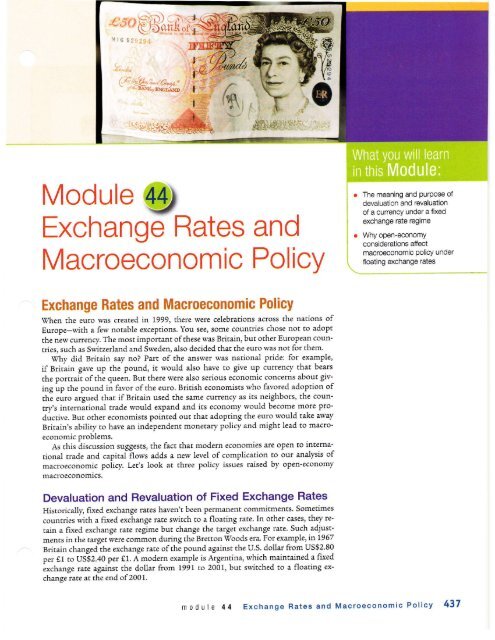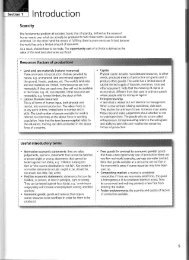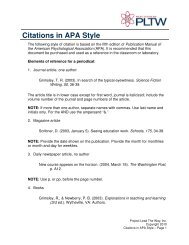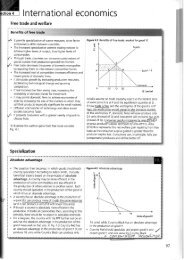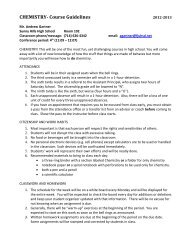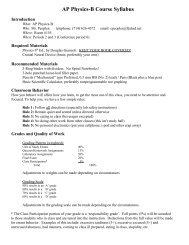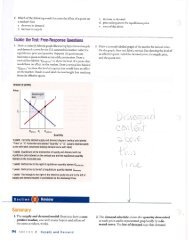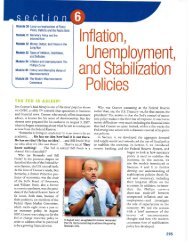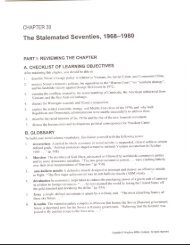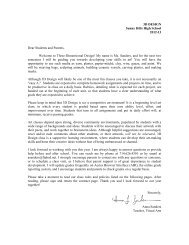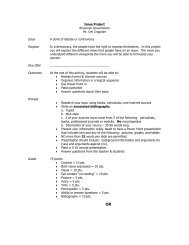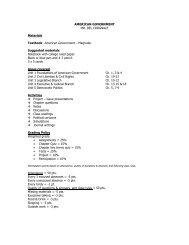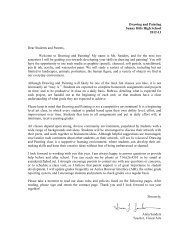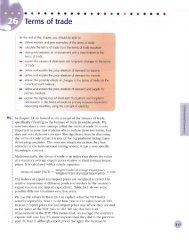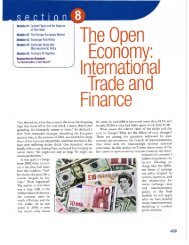AP Econ Module 44 Exchange Rates and Policy - Sunny Hills High ...
AP Econ Module 44 Exchange Rates and Policy - Sunny Hills High ...
AP Econ Module 44 Exchange Rates and Policy - Sunny Hills High ...
Create successful ePaper yourself
Turn your PDF publications into a flip-book with our unique Google optimized e-Paper software.
li ].)rti;ii,,t J.<br />
'f<br />
'!: / --.t '<br />
lu..,rti r:ler/u.,1<br />
<strong>Module</strong> y)<br />
<strong>Exchange</strong> <strong>Rates</strong> <strong>and</strong><br />
Macroeconomic <strong>Policy</strong><br />
<strong>Exchange</strong> <strong>Rates</strong> <strong>and</strong> Macroeconomic Folicy<br />
'When the euro was created in 1999, there were celebrations across the nations of<br />
Europe-with a few notable exceptions. You see, some countries chose not to adopt<br />
the new currency. The most important ofthese was Britain, but other European counrries,<br />
such as Switzerl<strong>and</strong> <strong>and</strong> Sweden, also decided that the euro was not for them<br />
Why did Britain say no? Patt of the answer was national pride: for example,<br />
if Britain gave up the pound, it would also have to give uP currency that bears<br />
the portrait of the queen. But there were also serious economic concerns about giving<br />
up the pound in favor ofthe euro British economists who favored adoption of<br />
th" eu.o .rgued thar if Britain used the same currency as irs neighbors, the country's<br />
international trade would exp<strong>and</strong> <strong>and</strong> its economy would become more Producrive.<br />
But other economists pointed out that adopting the euro would take away<br />
Brirain's ability to have an independent monetary policy <strong>and</strong> might lead to macroeconomic<br />
problems.<br />
As this discussion suggests, the fact that modern economies are open to international<br />
trade <strong>and</strong> capital flows adds a new level of complication to our analysis of<br />
macroeconomic policy. Let's look at three policy issues raised by oPen-economy<br />
mactoeconomics.<br />
Devaluation <strong>and</strong> Revaluation of Fixed <strong>Exchange</strong> <strong>Rates</strong><br />
Historically, fixed exchange rates haven't been permanent commitments Sometimes<br />
countries with a fixed exchange rate switch to a floating rate. In other cases, they retain<br />
a fixed exchange rate tegime but change the target exchange rate. Such adjustments<br />
in the target were common during the Bretton lffoods era. For example,in L967<br />
Britain changed the exchange rate ofthe pound against the U.S. dollar from US$2 80<br />
per e1 to US12.40 per C1. A modern example is Argentina, which maintained a fixed<br />
rate against the dollar from 1991 to 2001, but switched to a floating ex-<br />
"*cha.g"<br />
change rare at the end of2001.<br />
The meaning <strong>and</strong> purpose of<br />
devaluation <strong>and</strong> revaluation<br />
of a currency under a fixed<br />
exchange rate regime<br />
Why op6n-economy<br />
considerations afiect<br />
macroeconomic PolicY under<br />
floating exchange rates<br />
m0dule <strong>44</strong> <strong>Exchange</strong> <strong>Rates</strong> <strong>and</strong> Macroeconomic <strong>Policy</strong> 437
From Bretton Woods to the Euro<br />
ln 19<strong>44</strong>, while World War ll was still raging,<br />
representatives of the Allied nations met in<br />
Bretton Woods, New Hampshire, to establish<br />
a postwar international monetary system of<br />
fjxed exchange rates among major currencies.<br />
The system was highly successful at first, but<br />
it broke down in 1971. After a conlusing inter-<br />
val during which policy makers tried unsuc-<br />
cessfully to establish a new fixed exchange<br />
rate system, by 1973 most economically ad-<br />
vanced countries had moved to floating ex-<br />
change rates.<br />
ln Europe, however, many policy makers<br />
were unhappy with floating exchange rates,<br />
which they believed created too much uncer-<br />
tainty for buslness. From the late 1970s on-<br />
ward they tried several times to create a<br />
system of more or less lixed exchange rates<br />
in Europe, culminating in an arrangement<br />
known as the <strong>Exchange</strong> Rate Mechanism, (Ihe<br />
<strong>Exchange</strong> Bate l\4echanism was, stric y speak-<br />
ing, a "target zone" system-exchange rates<br />
were free to move within a narrow b<strong>and</strong>, but<br />
not 0utside it.)And in 1991 they agreed to<br />
move to the ultimate in fixed exchange rates:a<br />
common European currency, the euro. T0 the<br />
surprise of many analysts, they pulled it offl<br />
today most ol Europe has ab<strong>and</strong>oned national<br />
currencies lor euros.<br />
A devaluation is a reduction in the value of<br />
a currency that ls set ufder a lixed excltange<br />
rate regime.<br />
A revaluation is an ncrease ln the value of<br />
a currency that is set under a fxed exchange<br />
rate reoime.<br />
The accompanying figure<br />
lllustrates the history of<br />
European exchange rate<br />
arrangements. lt shows the<br />
exchange rate between the<br />
French franc <strong>and</strong> the Ger-<br />
man mark, measured as<br />
francs per mark, sjnce<br />
1971. The exchange rate<br />
fluctuated widely at first.<br />
The "plateaus" you can see<br />
in the data-eras when the<br />
exchange rate tluctuated<br />
only modestly-are periods<br />
when attempts to restore<br />
fixed exchange rates were<br />
in process. The <strong>Exchange</strong><br />
Rate Mechanism, after a<br />
couple of false starts, became efiectjve in 1987,<br />
stabilizing the exchange rate at about 3.4 francs<br />
per mark. Ohe wobbles in the early 1990s re-<br />
flect two currency crises-episodes in which<br />
widespread expectations of imminent devalua-<br />
tions led to large but temporary capitalflows.)<br />
ln 1999 the exchange rate was ,,locked,,-no<br />
further fluctuations were allowed as the coun-<br />
tries prepared to switch from francs <strong>and</strong> marks<br />
to euros, At the end of 2001, the lranc <strong>and</strong> the<br />
mark ceased to exist.<br />
<strong>Exchange</strong><br />
rate<br />
(francs<br />
per mark)<br />
FF4.O<br />
3.0<br />
2.0<br />
7.5<br />
Attenpts to<br />
stabiLize rotes<br />
<strong>Exchange</strong> rdte<br />
nechonisn<br />
^,f ^"4" g$s gtr gqs ,""t<br />
The transition to the euro has not been with-<br />
out costs. With most of Europe sharing the<br />
same currency, it must also share the same<br />
monetary policy. Yet economic conditions jn the<br />
different countries aren't always the same,<br />
lndeed, as this book went to press, there<br />
were serious stresses within the eurozone be-<br />
cause the world financial crisis was hitting<br />
some countries, such as Greece. Portugal, Spain<br />
<strong>and</strong> lrel<strong>and</strong>, much more severely than it was<br />
hitting others, notably Germany.<br />
Exchonge<br />
rctes locked<br />
befure euro<br />
Year ""e<br />
A reduction in rhe value ofa currency that is set under a fixed exchange rate regime<br />
is called devaluation. As we've already learned, a depreciation is a downward move in a<br />
currency. A devaluation is a depreciation rhat is due to a revision in a fixed. exchange<br />
rate target. An increase in the value ofa currenry that is set under a fixed exchange rate<br />
regime is called a revaluation.<br />
devaluation, like any depreciation, makes domestic goods cheaper<br />
-A in terms<br />
of foreign currency, which leads to higher exports, Aa the iame time, it makes foreign<br />
g-oods more expensive in terms of domesric currency, which reduces imports.<br />
The effect is to increase the balance ofpayments on the.r'rrr"rrt...or._rrrt. Similirly, a<br />
revaluatio_n makes domestic goods more expensive in terms of foreign currency,<br />
which reduces exports, <strong>and</strong> makes foreign goods cheaper in domesiic .or."r.y,<br />
which increases imports. So a revaluation reduces the balance of payments on the<br />
cutrent account.<br />
Devaluations <strong>and</strong> revaluations serve two purposes under a fixed exchange rate<br />
regime. First, they can be used to eliminate shortages or surpluses in the foreign ex_<br />
change market, For example, in 2010, some were urging China to re.ralue<br />
".o.ro-i.t,<br />
438 sectlon 8 The Open<br />
<strong>Econ</strong>omy: lnternationat Trade <strong>and</strong> Finance
the yuan so that it would not have to buy up so many U.S. dollars on the foreign exchange<br />
market.<br />
Second, devaluation <strong>and</strong> revaluation can be used as tools of macroeconomic policy.<br />
A devaluation, by increasing exports <strong>and</strong> reducing imports, increases aggregate<br />
dem<strong>and</strong>. So a devaluation can be used to reduce or eliminate a recessionary gap. A<br />
revaluation has the opposite effect, reducing aggregate dem<strong>and</strong>. So a revaluation can<br />
be used to reduce or eliminate an inflationary gap.<br />
Monetary <strong>Policy</strong> Under a Floating <strong>Exchange</strong><br />
Rate Regime<br />
Under a floating exchange rate regime, a country's central bank retains its abiliry to<br />
pursue independent monetary policy: it can increase aggregate dem<strong>and</strong> by cutting the<br />
interest rate or decrease aggregate dem<strong>and</strong> by raising the interest rate. But the exchange<br />
rate adds another dimension to the eflects ofmonetary poliry To see why, let's<br />
return to the hypothetical country ofGenovia as discussed in <strong>Module</strong> 43 <strong>and</strong> ask what<br />
happens ifthe cenrral bank cucs rhe interest rate.<br />
Just as in a closed economy, a lower interest rate leads to higher investment spending<br />
<strong>and</strong> higher consumer spending. But the decline in the interest rate also affects<br />
the foreign exchange market. Foreigners have less incentive to move funds into Genovia<br />
because they will receive a lower rate of return on their loans. As a result, they<br />
have Iess need to exchange U.S. dollars for genos, so the dem<strong>and</strong> for genos falls. At<br />
the same time, Gen ovians have more incentive to move funds abroad because the rate<br />
ofrerurn on loans at home has fa.llen, making investments outside the country more<br />
artractive. Thus, they need to exchange more genos for U.S. dollars <strong>and</strong> the supply of<br />
genos rises.<br />
Figure <strong>44</strong>.1 shows the effect ofan interest rate reduction on the foreign exchange<br />
market. The dem<strong>and</strong> curve for genos shifts leftward, from Dr to D2, <strong>and</strong> the supply<br />
curve shifts rightward, from 51 to 52. The equilibrium exchange tate, as measured in<br />
U.S. dollars per geno, falls fromXRl to XR2. That is, a reduction in the Genovian inter-<br />
est rate causes the geno to d,epreciate,<br />
The depreciation ofthe geno, in turn, affects aggregate dem<strong>and</strong>. We've already seen<br />
that a devaluation-a depreciation that is the result of a change in a fixed exchange<br />
Monetary <strong>Policy</strong> <strong>and</strong><br />
the <strong>Exchange</strong> Rate<br />
Here we show what happens in<br />
the foreign exchange market if<br />
Genovia cuts its interest rate.<br />
Residents ol Genovia have a re-<br />
duced incentive to keeptheir<br />
fuflds at home, so they invest<br />
more abroad. As a result, the<br />
supply of genos shifts rightward,<br />
from .t to S. lveanwhile, foF<br />
eigners have less incentive to put<br />
funds into Genovia, so the de-<br />
m<strong>and</strong> for genos shifts leftward,<br />
lrom 4 to 02.The geno depreci-<br />
ates: the equilibrium exchange<br />
rate falls from x& to XAr.<br />
<strong>Exchange</strong><br />
rate<br />
(U.S. dottars<br />
per geno)<br />
3. ...leoding to<br />
o depreciotion<br />
of the geno.<br />
XRt<br />
lXRz<br />
1. Aftet the ienovion interest<br />
rute falk, Genovians invest<br />
S" nore obrcdd, buying norc U.S.<br />
' dollor. ond selling more genos...<br />
?D1<br />
2. ..-qnd foreignes invest<br />
Iess in Genovio, reducing<br />
thei denqnd Jot genos,,..<br />
0uantlty of genos<br />
module <strong>44</strong> <strong>Exchange</strong> <strong>Rates</strong> <strong>and</strong> Macroeconomic <strong>Policy</strong> 439
For better orworse, trading partners<br />
tend to import each other! buslness cycles<br />
in addition to each other! goods.<br />
rate-increases exports <strong>and</strong> reduces imports, thereby increasing aggregete dem<strong>and</strong>. A<br />
depreciation that results from an interes! rate cut has the same effecc ir increases exports<br />
<strong>and</strong> reduces imports, increasing aggregate dem<strong>and</strong>,<br />
In other words, monetary policy under floating rates has effects beyond those we,ve<br />
described in looking at closed economies. In a closed economy, a reduction in the interest<br />
rate leads to a rise in aggregate demaad because it leads to more inveslrnenr<br />
spending <strong>and</strong> consumer spending, In an open economy with a floating exchange rate,<br />
the interest rate reduction leads to increased investment spending <strong>and</strong> consumer<br />
spending, but it also increases aggregate dem<strong>and</strong> in another way: it leads ro a curencF<br />
depreciation, which increases exports <strong>and</strong> reduces imports, further increasing aggregate<br />
dem<strong>and</strong>.<br />
lnternational Business Cycles<br />
Up to chis point, we have discussed macroeconomics, even in an open economy, as ifall<br />
dem<strong>and</strong> changes o r shochs origna;ted. from the domestic economy. In reality, however,<br />
economies sometimes fare shocks coming from abroad. For example, recessions in the<br />
United States have historically led to recessions in Mexico.<br />
The key point is that changes in aggregate dem<strong>and</strong> affect the dem<strong>and</strong> for goods <strong>and</strong><br />
services produced abroad as well as at home; other things equal, a recession leads to a<br />
fall in imports <strong>and</strong> an expansion leads ro a rise in imports, And one country's imports<br />
are another countqy's exporrs. This link between aggreg*e dem<strong>and</strong> in different nadonal<br />
economies is one reason business cycles in different countries sometimes-but<br />
not always-seem to be synchronized. The prime example is the Grear Depression,<br />
which affected countries around the wodd.<br />
The extenc of this link depends, however, on rhe exchange rate regime. To see why,<br />
think about what happens ifa recession abroad reduces the dem<strong>and</strong> for Genovia's exports,<br />
A reduction in foreign dem<strong>and</strong> for Genovian goods <strong>and</strong> services is also a reduction<br />
in dem<strong>and</strong> for genos on the foreign exchange market. If Genovia has a fixed<br />
exchange rate, it responds ro rhis decline with exchange market intervendon. But if<br />
Genovia has a floating exchange rate, the geno depreciates. Because<br />
Genovian goods <strong>and</strong> services become cheaper ro foreigners when<br />
the dem<strong>and</strong> for exporrs falls, the quantiry ofgoods <strong>and</strong> services exported<br />
doesn't fall by as much as ir would under a fixed rate. Ar the<br />
sarne time, the fall in the geno makes imports more expensive to<br />
Genovians, leading to a fall in imports. Both effects limit the decline<br />
in Genovia's tggregate dem<strong>and</strong> compared to what ir would<br />
have been under a fixed exchange rate regime,<br />
One ofthe virtues offloating exchange rates, according to their<br />
advocates, is that they help insulate countries from recessions<br />
originating abroad. This theory looked pretty good in the early<br />
2000s: Britain, with a floating exchange rare, managed to stay out<br />
ofa recession that affected the rest ofEurope, <strong>and</strong> Canad4 which<br />
also has a floating rate, suffered a less severe recession than the<br />
United States.<br />
In 2008, however, a financial crisis that began in the United States seemed to be producing<br />
a recession in virtually every country. In this case, ir appears rhat the international<br />
linkages between financial markets were much stronger than arty insulation<br />
from overseas disturbances provided by floating exchange rates.<br />
<strong>44</strong>O section I The Open <strong>Econ</strong>omy: lnternational Trade <strong>and</strong> Financ6
The Joy of a Devalued Pound<br />
The <strong>Exchange</strong> Rate Mechanism is the system of<br />
European fixed exchange rates that paved the<br />
way lorthe creation ofthe euro in 1999. Britain<br />
joined that system in 1990 but dropped out in<br />
1992.The story of Britain s exit from the Ex-<br />
change Bate lllechanism is a classic example of<br />
open-economy macroecon0mic policy,<br />
Britain originally fixed its exchange rate for<br />
both the reasons we described earlier: gritish<br />
leaders believed that a tixed exchange rate<br />
would help promote internationaltrade, <strong>and</strong><br />
they also hoped that itwould help tight inllation.<br />
But by 1992 Britain was suffering from high un-<br />
employment the unemployment rate in Sep-<br />
tember '1992 was over 100/0. And as long as the<br />
country had a fixed exchange rate, there wasn't<br />
much the government could do. ln particular,<br />
the government wasn't able to cut interest rates<br />
because it was using high interest rates t0 help<br />
support the value ot the pound,<br />
ln the summer of 1992, inveshrs began spec-<br />
ulating againstthe pound---€ellin0 pounds in the<br />
@<strong>44</strong><br />
Solutions appedr at the bdck afthe book,<br />
Check Your Underst<strong>and</strong>ing<br />
expectation that the currency would drop in<br />
value,As its foreign reserves dwindled, this spec-<br />
ulation forced the British government's h<strong>and</strong>, 0n<br />
September 10, 1992, Brihin ab<strong>and</strong>oned ih fixed<br />
exchange rate. The pound promptly dropped 20%<br />
against the German mark, the most important<br />
European currency at the time.<br />
At tirst, the devaluation ot the pound greatly<br />
damaged the prestige olthe British government.<br />
But the Chancellor ot the Exchequer-the equivale<br />
0f he U.S. Treasury secretary---claimed h<br />
be happy about it, "l!ly wife has never belore<br />
heard me singing in the bath," he told reporters.<br />
There were several reasons lor his joy, one was<br />
that the British governmentwould no longer have<br />
to enoage in large-scale exchange market inteF<br />
vention to supportthe pound's value.Another was<br />
that devaluation increas€s agoregate dem<strong>and</strong>, s0<br />
the pound's lall would help reduce British unem-<br />
ployment. Finally, because Britain no longer had a<br />
fixed exchange rate, it was free lo pursue an ex-<br />
pansionary monetary policy h fight its slump.<br />
1. Look at the graph in the FYI section on page 438. Where do you<br />
see devaluations <strong>and</strong> revaLr.rations ofthe franc against the mark?<br />
2. In the lare 1980s, Canadian economists atgued that che high<br />
interest rate policies ofthe Bank ofCanada weren'tjust causing<br />
high unemployment-they were also making it hard for<br />
Tackle the Test Multiple-Choice Ouestions<br />
1. Devaluation ofa currency occurs when which ofche following<br />
happens?<br />
L The supply ofa currenry with a floacing exchange tate<br />
increases.<br />
II. The dem<strong>and</strong> for a currency with a floating exchange rate<br />
decreases.<br />
IIL The government decreases the fixed exchange rate<br />
lndeed, events made it clear that the chan-<br />
cellor's joy was wellfounded. British unemploy-<br />
ment fell over the next two years, even as the<br />
unemployment rate rose in France <strong>and</strong> Ger-<br />
many. one person who did not share in the im-<br />
proving employment picture, however, was the<br />
chancellor himself. Soon after hi6 remark about<br />
singing in the bath, he was fired.<br />
Canadian manufacturers to compete with U S manufaccurers.<br />
Explain this complaint, using our analysis ofhow monetary<br />
policy rvorks under floating exchange rates.<br />
a. I only<br />
b. II only<br />
c. III only<br />
d. I <strong>and</strong> II only<br />
e. I,II, <strong>and</strong> III<br />
rn 0 d u le 4 4 <strong>Exchange</strong> <strong>Rates</strong> <strong>and</strong> Macroeconomic <strong>Policy</strong> <strong>44</strong>1
2. Devaluarion ofa curency will lead to which ofthe following?<br />
a. appreciation ofthe currency<br />
b, an increase in exports<br />
c. an increase in imports<br />
d. a decrease in exporrs<br />
e. floating exchange rares<br />
3. Devaluation ofa currency is used to achieve which ofrhe<br />
following?<br />
a- an elimination ofa surplus in the foreign exchange market<br />
b. an elimination ofa shortage in the foreign exchange market<br />
c. a reduction in aggregare dem<strong>and</strong><br />
d. a lower inflation rate<br />
e. a floating exchange tate<br />
Tackle the Test: Free-Response Questions<br />
1 Suppose the Unired States <strong>and</strong> Ausrralia were the only two<br />
couotries in the world, <strong>and</strong> thar both counrries pursued a<br />
floating exchange rare regime, Note tha[ rhe currency in<br />
Australia is the Ausrdian dollar.<br />
a. Draw a correcdy labeled graph showing equilibrium in the<br />
foreign exchange market for U.S. dollars.<br />
b. Ifthe Federal Reserve pursues expansionaf,y monerary<br />
policy, whar will happen to the U.S. interesr rare <strong>and</strong><br />
intemacional capiral flows? Explain.<br />
c. On your graph ofthe foreign exchange market, illusrrate<br />
the effecr ofrhe Fed's policy on rhe supplyofU.S. dollars,<br />
the dem<strong>and</strong> for U.S. dollars, <strong>and</strong> the equilibrium exchange<br />
late.<br />
d. How does the Fed's monerary poliry affec U.S. aggregate<br />
dem<strong>and</strong>? Explain.<br />
Answer (1 0 polnts)<br />
<strong>Exchange</strong> late<br />
(Austrdtl.n<br />
dotlaE per<br />
U.S. dottar)<br />
1, Aftet the U.S. inteest tob<br />
Iolk, U,S, investo9 sell note<br />
U,S, dolloR in achonge ht<br />
Austtolidn doUaR...<br />
...a 2. ...ond Austrolions<br />
den<strong>and</strong> fewer U.S.<br />
2,<br />
dollaR with which to<br />
invett in the U.S. ...<br />
D1<br />
0 Quantlty of t .S. dottaE<br />
I polnt The vertical axls Is labeled "<strong>Exchange</strong> rats (Australian dollars per U,S,<br />
dolla0" <strong>and</strong> th8 horlzontal axis ls labeted ,,ouan ty ot U.S. dollars.,'<br />
1 polnt Dem<strong>and</strong> is downward sloping <strong>and</strong> labetedi supply is upward sloping<br />
<strong>and</strong> lebeled.<br />
XRt<br />
,l<br />
/+<br />
/ xR"<br />
3. ...leoding to<br />
o deprcciotbn of<br />
the U.S. dollar<br />
52<br />
4. Monetaly policy rhat reduces the interesr rare will do which of<br />
the following?<br />
a. appreciate the domesric currency<br />
b. decrease exports<br />
c. inclease imports<br />
d. depreciate the domesric currency<br />
e. prevent inflation<br />
5. Vhich of rhe following will happen in a counrry ifa trading<br />
partneis economy experiences a recession?<br />
a. It will experience an expansion.<br />
b. Exports will decrease.<br />
c. The dern<strong>and</strong> for the counry's currency will increase.<br />
d. The country's currency will appreciate,<br />
e. All ofthe above will occur.<br />
1 pointi The equilibrlum exchang8 rate <strong>and</strong> equilibrlum quantity 0f dollars are<br />
labeled on the axes at the polntwhsre the suppty <strong>and</strong> dem<strong>and</strong> curvos<br />
lntersect.<br />
1 point Tho U.S. interest rat€ ta s.<br />
1 polnt Thero is an increase ln the capital flow intoAustalla <strong>and</strong> an increase<br />
ln the capihl tlow out of the Unlted States.<br />
1 pdft The lower interest rate in the Unltsd Shtes reduces ltls incenflvs h<br />
invest in tho Unlted States <strong>and</strong> lncreasss ths lncentve h invssl in Australia.<br />
1 point The supply of u.S, dollars increases.<br />
1 point The dem<strong>and</strong> for u.S. dollars decreases.<br />
1 polnt lhe exchange rato lalls (the U.S. dollar depreciates).<br />
1 point Ths lower exchangs rate leads h moro exports trom the United<br />
Statos t0 Australia (they are choaper now) <strong>and</strong> fewor imports into the Unitsd<br />
Stabs ftom Australia (h8y ar8 more oxpensive now). When oxporb lncrease<br />
<strong>and</strong> imports docreass, U.S. aggregat8 dsm<strong>and</strong> lncreases.<br />
2. Explain how a floating exchange rare system can help insulate<br />
a country from recessions abroad.<br />
<strong>44</strong>2 sectlon 8 The Open <strong>Econ</strong>omy: lnternationat Trade <strong>and</strong> Finance


